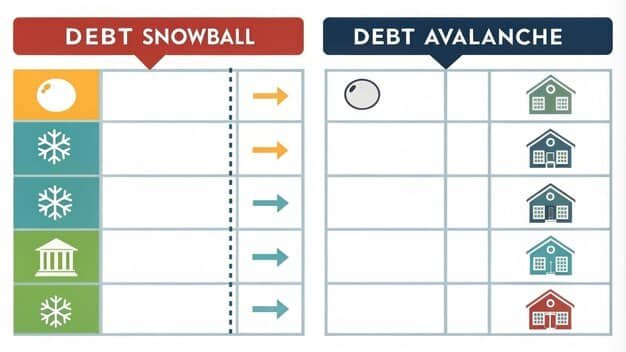Debt Snowball vs. Debt Avalanche: Which Strategy Saves More?

The debt snowball and debt avalanche methods are two popular strategies for tackling debt, each offering unique approaches to prioritization and motivation; understanding their differences is crucial for selecting the most effective path to financial freedom.
Choosing the right debt repayment strategy can significantly impact your journey to financial freedom. Two popular methods, the debt snowball vs. debt avalanche, offer distinct approaches to tackling your debts. Understanding the nuances of each can help you decide which one best suits your financial situation and personality.
Understanding the Debt Snowball Method
The debt snowball method is a debt reduction strategy where you pay off your debts in order from smallest to largest, regardless of the interest rate. This method focuses on providing quick wins and psychological motivation as you see your debts disappearing one by one.
How the Debt Snowball Works
The debt snowball method begins by listing all your debts from the smallest balance to the largest. You make minimum payments on all debts except for the smallest one, where you allocate any extra funds you have available. Once the smallest debt is paid off, you take the money you were using to pay that debt and apply it to the next smallest debt, and so on. This creates a snowball effect as you have more and more money to put toward each subsequent debt.
Benefits of the Debt Snowball
- Motivation: The quick wins provide a psychological boost, making you feel more motivated to continue paying off your debts.
- Simplicity: It’s easy to understand and implement.
- Momentum: As you pay off debts, the momentum can help you stay on track.
The focus on quick wins can be particularly beneficial for people who need to see immediate progress to stay motivated. Seeing those smaller debts disappear can give you the confidence to tackle larger, more daunting debts.
Understanding the Debt Avalanche Method
The debt avalanche method is a debt reduction strategy where you pay off your debts in order from highest interest rate to lowest, regardless of the balance. This method is mathematically the most efficient way to pay off debt, as it minimizes the amount of interest you pay over time.

How the Debt Avalanche Works
To use the debt avalanche method, list all your debts from the highest interest rate to the lowest. Make minimum payments on all debts except for the one with the highest interest rate, where you put any extra money you have. Once the debt with the highest interest rate is paid off, you move on to the debt with the next highest interest rate, and so on. By focusing on high-interest debts first, you reduce the overall cost of your debt repayment.
Benefits of the Debt Avalanche
- Saves Money: It minimizes the total interest paid over time.
- Efficiency: It’s the mathematically optimal way to pay off debt.
- Long-Term Financial Health: It sets you up for better financial health by reducing the burden of high-interest debt.
While it may take longer to see initial results with the debt avalanche method, the long-term financial benefits can be substantial. By minimizing interest payments, you can free up more money to invest and save for the future.
Debt Snowball vs. Debt Avalanche: A Detailed Comparison
When deciding between the debt snowball vs. debt avalanche methods, consider your individual financial situation and your personal preferences. Both methods can be effective if you stay committed to the strategy.
Psychological Impact
The debt snowball method can provide a psychological boost due to the quick wins it offers. This can be particularly helpful if you find it difficult to stay motivated when facing long-term financial goals. The sense of accomplishment from paying off smaller debts can give you the momentum to tackle larger ones.
On the other hand, the debt avalanche method may not provide the same immediate gratification. It requires patience and discipline, as the initial focus is on high-interest debts that may take longer to pay off. However, the long-term financial benefits can be significant and can lead to a greater sense of accomplishment over time.
Mathematical Efficiency
From a purely mathematical perspective, the debt avalanche method is more efficient. By paying off high-interest debts first, you minimize the amount of interest you pay over time. This can save you hundreds or even thousands of dollars in interest payments.
Flexibility and Adaptability
Both the debt snowball and debt avalanche methods can be adapted to fit your individual financial situation. You can adjust your budget, find ways to increase your income, or refinance your debts to lower interest rates. The key is to find a strategy that works for you and stick with it.
Ultimately, the choice between the debt snowball vs. debt avalanche depends on your personal preferences and financial personality. Some people thrive on the quick wins of the debt snowball, while others are more motivated by the long-term financial benefits of the debt avalanche.
Which Method is Right for You?
Choosing between the debt snowball vs. debt avalanche methods involves considering several factors. Your financial situation, personality, and motivation all play a role in determining which strategy is the best fit.

Assess Your Financial Situation
Start by listing all your debts, including the balance, interest rate, and minimum payment. This will give you a clear picture of your overall debt and help you determine the best approach. Consider whether you have many small debts or a few large, high-interest debts.
Consider Your Personality and Motivation
- Are you motivated by quick wins? If so, the debt snowball may be a better choice.
- Are you mathematically inclined and focused on saving money? The debt avalanche could be more appealing.
- Do you need a structured plan, or do you prefer flexibility? Both methods can be adapted to fit your needs.
Your personality and motivation are critical factors in choosing the right debt repayment strategy. If you’re easily discouraged, the debt snowball’s quick wins can keep you motivated. If you’re driven by efficiency and saving money, the debt avalanche might be more your style.
Seek Professional Advice
If you’re unsure which method is right for you, consider seeking advice from a financial advisor. A professional can help you assess your financial situation, create a personalized debt repayment plan, and provide ongoing support and guidance.
Both the debt snowball vs. debt avalanche can be effective strategies for paying off debt. The key is to choose a method that aligns with your financial situation, personality, and motivation. With commitment and discipline, you can achieve your financial goals and become debt-free.
Tips for Successfully Implementing Your Chosen Strategy
Once you’ve chosen between the debt snowball vs. debt avalanche, it’s essential to implement your strategy effectively. Here are some tips to help you stay on track and achieve your debt repayment goals.
Create a Budget
A budget is a crucial tool for managing your finances and allocating money towards debt repayment. Track your income and expenses to identify areas where you can cut back and free up more money for debt payments. Use budgeting apps, spreadsheets, or a notebook to keep track of your progress.
Increase Your Income
Finding ways to increase your income can accelerate your debt repayment efforts. Consider taking on a part-time job, freelancing, selling items you no longer need, or asking for a raise at your current job. Every extra dollar you earn can be put towards your debt, helping you reach your goals faster.
Automate Your Payments
Automating your debt payments can help you avoid late fees and stay consistent with your repayment plan. Set up automatic payments for at least the minimum amount due on each debt, and consider automating extra payments towards your chosen debt repayment strategy. Automation can reduce stress and ensure you stay on track.
Stay Focused and Motivated
Staying focused and motivated is key to successfully paying off debt. Celebrate your small wins, track your progress, and remind yourself of your long-term financial goals. Stay connected with a supportive community or seek advice from a financial advisor to help you stay on track.
By following these tips and staying committed to your chosen debt repayment strategy, you can achieve your financial goals and become debt-free. Remember that both the debt snowball vs. debt avalanche methods require discipline and perseverance, but the rewards of financial freedom are well worth the effort.
| Key Aspect | Brief Description |
|---|---|
| 💰Debt Snowball | Focuses on paying off smallest debts first for quick wins. |
| 📉Debt Avalanche | Prioritizes debts with the highest interest rates to save money. |
| 🧠Psychological Impact | Snowball offers quicker psychological wins; avalanche is about long-term savings. |
| 🎯Implementation | Create a budget, increase income, and automate payments to succeed. |
Frequently Asked Questions (FAQ)
▼
The debt snowball focuses on paying off the smallest debts first, while the debt avalanche prioritizes debts with the highest interest rates, regardless of the balance.
▼
The debt avalanche method typically saves more money in the long run because it targets high-interest debts first, reducing the overall interest paid.
▼
Yes, many people find it psychologically more rewarding because it provides quick wins, which can be motivating and help them stick to their debt repayment plan.
▼
Yes, you can create a hybrid approach. For example, you could pay off a small debt quickly for motivation and then switch to the avalanche method to tackle high-interest debts.
▼
If your debts have similar interest rates, you can use the debt snowball method or simply choose the debt with the smallest balance to pay off first for a quick win.
Conclusion
In summary, both the debt snowball and debt avalanche methods offer effective strategies for debt repayment, with the best choice depending on individual preferences and financial situations. The debt snowball provides psychological wins, while the debt avalanche focuses on minimizing interest payments. By assessing your debts, considering your personality, and staying committed to your chosen strategy, you can achieve financial freedom and successfully manage your debt.





